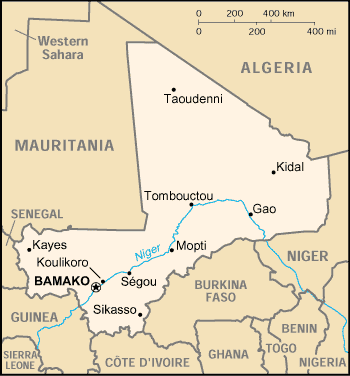Welcome to the Virtual Education Wiki ~ Open Education Wiki
Mali: Difference between revisions
| Line 41: | Line 41: | ||
<!--(this is an important section)--> | <!--(this is an important section)--> | ||
#University of Timbuktu | #University of Timbuktu | ||
#University of Sankore | #University of Sankore | ||
#University of Bamako | #University of Bamako | ||
Revision as of 11:21, 21 April 2011
author byline
Experts situated in Mali
Mali in a nutshell

Mali, officially the Republic of Mali (French: République du Mali), is a landlocked nation in Western Africa. Mali is the seventh largest country in Africa, bordering Algeria on the north, Niger on the east, Burkina Faso and the Côte d'Ivoire on the south, Guinea on the south-west, and Senegal and Mauritania on the west.
Its size is just over 1,240,000 km² with an estimated population of more than 14 million (July 2011 CIA est.).
Its capital is Bamako.
Consisting of eight regions, Mali's borders on the north reach deep into the middle of the Sahara, while the country's southern region, where the majority of inhabitants live, features the Niger and Senegal rivers. The country's economic structure centers around agriculture and fishing. Some of Mali's natural resources include gold, uranium, and salt. Mali is considered to be one of the poorest nations in the world.
Its official language is French.
Education in Mali
Mali has the lowest literacy rate in the world, with less than one quarter (23%) of adults and young people (29% aged 15–24) being able to read and write. Despite basic education being free, children are not guaranteed a decent education due to lack of materials and teachers, poor infrastructure and large classes. In state primary schools, there is one teacher for 64 pupils on average, Oxfam estimating a workforce gap of 27,000 teachers, while fewer than half of those employed have any training at all. The cost of education, as well as any discernible benefit, has increased parental opposition to sending their children, especially girls, to school. Over one third of children in the 7–12 age group are out of school. 60% of these are girls.
School-level education
School is compulsory and free for nine years from the age of six.
Primary level Primary education covers grades 1–6. In 6th grade students sit the CEP which leads to the 2nd cycle, grades 7 to 9 (junior high school). In grade 9, students take the Diplôme d’Etudes Fondamentale (DEF) which leads to either (a) high school or (b) vocational and technical school.
Secondary level Secondary education or senior high school covers grades 10-12. All grade 12 students sit the baccalaureate exam (high school diploma) in biology, maths/physics,human sciences, or language and literature.
Vocational education Vocational school programs run from 2 to 4 years, the former offering the Certificat d’Aptitude Professionnelle (CAP), the latter the Brevet de Technicien (BT).
English is introduced and taught as a foreign language at grade 7.Arabic, German, and Russian are introduced at grade 10.
Further and Higher education
Universities in Mali
- University of Timbuktu
- University of Sankore
- University of Bamako